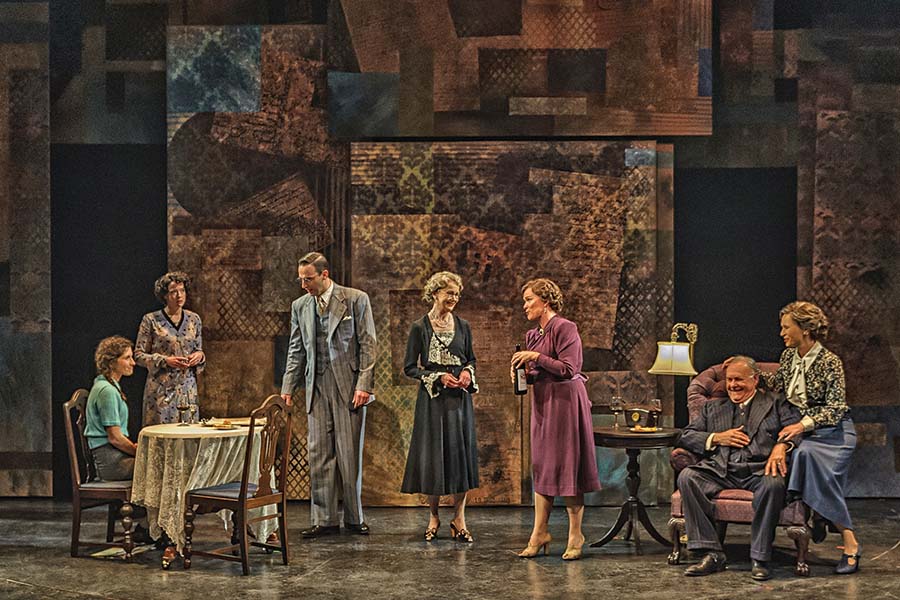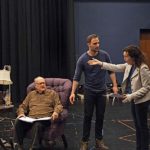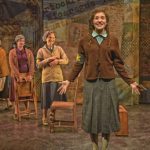Richard S. Hollander hoped that the Baltimore production of The Book of Joseph would hit theatregoers “in the gut and the heart.” That goal was achieved, if physical reactions are anything to go by. Attending the show at Baltimore’s Everyman Theatre this past spring, Hollander saw audience members sobbing. “Tears running down their faces!” he marvels. He even saw some of the actors cry after curtain call on opening night. “I’d love to have the tissue concession in the lobby,” he jokes.
Hollander cares about The Book of Joseph because it recounts a story about his family: Dramatist Karen Hartman based the play on Every Day Lasts a Year: A Jewish Family’s Correspondence From Poland, a nonfiction volume first published in 2007, comprising letters that members of the Hollander family wrote from Krakow, in German-occupied Poland, between 1939 and 1941. Nearly a half century after the letter writers vanished, presumably falling victim to the Holocaust, Hollander discovered the correspondence in the attic of his recently deceased parents’ home in a New York City suburb. Later, collaborating with two Holocaust scholars, he co-wrote and co-edited Every Day Lasts a Year.
Hollander himself is a character in Hartman’s play, which is set partly in Krakow, and partly in U.S. locations, including his hometown of Baltimore. “I’ve never quite come across a play that’s so local, yet so global at the same time,” says Vincent M. Lancisi, Everyman’s founding artistic director.
The local angle may have whet audiences’ appetite when The Book of Joseph opened in Baltimore in May 2018: After breaking Everyman’s record for advance ticket sales, the production displaced Fences as the highest-grossing show in the theatre’s 28-year history.
But geography was probably not the only reason for the smashing success. First produced in 2017 by Chicago Shakespeare Theater, which commissioned it, Hartman’s play recalls life and suffering during the Holocaust. But it is also an often funny meditation on the universal topics of family and self-knowledge.
The play also resonates with contemporary concerns about anti-immigrant sentiment. When Hollander discovered his family letters—still in their original swastika-marked envelopes, neatly arranged in a briefcase—he realized they had been sent by the immediate relatives of his father, Joseph A. Hollander, who had escaped Poland in 1939. Arriving at Ellis Island, Joseph had found himself persona non grata: Indeed the U.S. waged an energetic battle to expel him because he had arrived without the right papers. Only by enlisting in the U.S. Army, thereby gaining citizenship, did Joseph earn the right to remain in the U.S.
In 1986, Joseph died in a car crash with his wife, leaving their son, Richard, to clean out their house. When he discovered the letter-packed briefcase, he was still deep in grief, so he put it aside for more than a dozen years—a delay that becomes a key point in Hartman’s play. When he finally read the correspondence and arranged for it to be translated, he learned that it was a rare, historically valuable trove of testimony about the Jewish experience in Holocaust-era Poland, which is what interested scholars Christopher R. Browning and Nechama Tec in collaborating with him on Every Day Lasts a Year.
Few readers would have seen the book as must-stage material. Cautiously worded in expectation of censorship (and for fear of alarming their loved one), the letters from Krakow describe few dramatic incidents, dwelling instead on innocuous matters, like the joy of receiving Joseph’s letters. Still, heart-stopping remarks sneak through. “I am breathing but I am not alive,” Joseph’s youngest sister observes at one point. In another passage, she notes that “among friends and acquaintances, tragic trips into the unknown have already started.”
To Chicago Shakespeare Theater artistic director Barbara Gaines, this was all dramatic gold. She had learned about the book from her brother, a sometime colleague of Richard Hollander’s. Every Day Lasts a Year, Gaines says, tells a story “about immigration and racism, but most of all it’s about family.” She adds, “Family—it’s an active noun, isn’t it?”
Gaines says she spent three years hunting for the right playwright, eventually settling on Hartman, who “could write in a universal landscape, with intimacy and sense of great delineation of character,” as well as with humor. Hartman was immediately intrigued by the Hollander family story, in part because, in the aftermath of her own father’s death, she had similarly stumbled across his correspondence and been flooded with emotion. The tale of the letter-packed briefcase “was one of those stories that just stuck in my gut,” the playwright says.
After a preparation process that included interviews to supplement the material in the book, Hartman wrote a play that not only recounts the story of Joseph Hollander and his Krakow kin, but also imagines Richard Hollander’s experience. In the first of the play’s two contrasting acts, a fictionalized Richard Hollander, ostensibly engaged in a book talk, introduces and comments upon his family’s World War II-era saga. In Act 2, Richard’s son Craig (another fictionalized version of a real person) insists on putting his dad at the center of the story, questioning Richard’s choices, such as his failure to ask about the whole ordeal when Joseph was alive. Craig also looks askance at his father’s more sentimental statements; the younger Hollander is willing to acknowledge the messier aspects of history.
When incorporating material from historical documents (letters, court transcripts), Hartman kept the (translated) original wording intact. But the sake of drama and comic relief, she took some liberties with her main character. “I create a character who is a bit more neurotic that the real Richard Hollander,” she admits.
Hollander concedes that it can be awkward having one’s real name used for a very fallible stage figure. But he believes the Richard in the play is a universal character, “a stand-in for everyone who has procrastinated, delayed,” or failed to “press the boundaries” of relationships, as he puts it.
Hartman’s successful navigation of the shoals of history-based drama would become a significant event in her own career. Work on The Book of Joseph “open[ed] a pathway for me as a playwright,” she says. The process expanded her creative toolkit and gave her a new confidence about drawing on other people’s stories, she believes: For example, among her three world premieres in the 2016-17 season was Roz and Ray, a play inspired by her father’s experience as a doctor during the AIDS crisis. “I don’t think I would have done that in the same way” without the Chicago Shakespeare commission, Hartman says.
Chicago Shakespeare produced the world premiere of The Book of Joseph in early 2017. Directed by Gaines and developed with creative producer Rick Boynton, the production “was a gigantic hit for us,” Gaines says.
Just before Gaines’s staging opened, Everyman’s Lancisi learned about the play from a board member. Impressed by the imprimaturs of Hartman, Gaines, and Chicago Shakes, he and his wife flew to the Windy City to catch a performance. The newly inaugurated President Trump had just issued his first travel ban; that executive order, not to mention the earlier campaign rhetoric, gave eerie topicality to the story of Joseph Hollander’s immigration ordeal. Watching the Chicago production, Lancisi experienced “a lot of ‘aha!’ moments,” he remembers. At intermission, he recalls, his wife told him Everyman had to produce The Book of Joseph: For starters, she reported, the ladies’ room was abuzz about the play.
At the time Everyman had nearly finalized its 2017-18 offerings, but Lancisi was still hoping to find “a big, important play to close out the season.” Hartman’s play fit the bill. In addition to its scope and thematic relevance, it offered substantive roles for members of Everyman’s resident acting company. Moreover, Everyman associate artistic director Noah Himmelstein was interested in directing the piece, whose daring narrative tactics and contemplation of the immigrant experience reminded him of the Michael John LaChiusa-scored musical Los Otros, which he had directed for Everyman in 2017.
Everyman’s Book of Joseph began rehearsals in April 2018, with a cast that included five members of Everyman’s resident acting company—including Bruce Randolph Nelson as Richard and Danny Gavigan as Joseph—and four other actors. In introductory remarks before the first read-through, Hartman noted how glad she was to see her script get its second production. Often, as a playwright, when a new work premieres, “you never know if anyone will see it again,” she reflects.
Over the course of the next weeks, the script’s trickier aspects made themselves apparent to the Everyman artists. Director Himmelstein realized that it would be vital to establish “an emotional intimacy that heightens the experience the family is going through,” while also evoking the distances in time and space that gave the saga a heartrending edge. As he puts it, early in the rehearsal period, his task would be a “continual balancing act.”
The narrative format was also a tough nut to crack. Since much of the play’s first act consisted of letter excerpts, stiltedness was a risk, even though Hartman had taken care to interweave texts so as to create flow and drama. Moreover, since the letters’ original wording appeared verbatim, there was the problem of conveying an unknown subtext: What terrible experiences were the Krakow Hollanders leaving out of their letters?
From an actor’s perspective, the correspondence excerpts presented a challenge, says Everyman resident company member Beth Hylton, who doubled as Joseph’s sister Klara and first wife, Felicja. Paralleling the desperate, hopeful trajectory of a WWII-era letter, the lines often had to be launched into a void, without the helpful give-and-take that comes from playing against another actor. “You’re looking directly at the audience and not getting the typical feedback that you get—eye contact, the response,” Hylton says. So “you must work harder to communicate.”
Cast as the jovial, book-hawking Richard, actor Nelson fretted about the play’s comedy. “It was pretty clear to me intuitively that when you tell the story of the Holocaust, you keep it reverent and appropriately sad, and maybe a little angry,” he says. The play’s humor “scared me a little bit.” He describes this fear in an early rehearsal—“I was quite emotional,” he recounts—but Hartman and Himmelstein were able to set his worry to rest, he says.
Himmelstein recalls that he and the actors co-devised important aspects of the staging during rehearsal: the transitions that showed the Poland-bound Hollanders moving from home to the Krakow ghetto, for instance. Because much of the play is based on relatively dry documents, “it required us to create our own language to make it active,” he says.
To help the actors with the correspondence excerpts, he at one point had Gavigan, seated in a rolling chair, roll in front of each actor as they were speaking, to represent the letter’s recipient, Joseph. “Nobody got through a pass of that without crying,” Himmelstein says. “And it made it very real.”
Meanwhile the designers had their own challenges to address. Set designer Daniel Ettinger saw a stimulating problem in the transitions that shuttled the play between decades and continents. His solution was to recommend Everyman invest in a donut revolve that could sweep scenic elements in and out, preserving what he calls “the fluidity and the poetry” of the segues. For some of the set’s vertical surfaces, Ettinger underscored the document motif by creating a design reminiscent of the German Dadaist Kurt Schwitters, known for collages strewn with print ephemera. Some of the projections designed by Ettinger’s colleague Caite Hevner also featured documents, creating a changing, layered effect that was thematically resonant yet subtle: The appearance of a new projection “was like a shift in the temperature of the air,” Ettinger says.
Ettinger is one of Everyman’s resident designers, as is David Burdick, who devised the Book of Joseph costumes. Burdick began his design process with research that included studying photographs of the Krakow Hollanders to get a sense of their individual personalities. (He had met Richard Hollander and “got a sense of who he was and his style” too.) To achieve an authentic period look for the female characters in the 1930s and ’40s scenes, Burdick bought vintage dress patterns online to serve as costume templates. (Etsy, in particular, “is a huge vintage resource,” he says.) He also found vintage ties and sweaters online. For a reproduction-vintage sweater, he turned to an online vendor who knits retro designs. “We don’t usually have the luxury to do custom knitting,” Burdick observes drily.
The costumes, like the family drama, weren’t static. “One of the things Noah and I really wanted to do was, to a certain extent, show the passage of time, but also sort of [the characters’] journey,” Burdick says. Accordingly, between scenes in Act I, female characters shed jewelry, exchanged high heels for low ones, and donned scarves and aprons and sweaters, to “show that journey of the war coming on and the loss that they’re experiencing.”
Before the war, the Krakow Hollanders were well off, also sophisticated and cosmopolitan. “Not Anatevka—think Central Park West,” the Richard character says when he introduces them. For her part composer and sound designer Elisheba Ittoop had the job of figuring out what kind of music this urbane clan would listen to around 1939.
“We wanted it to sound like America at this time,” says Ittoop. “We didn’t want to throw it into, ‘These people are different from us.’” Her research led her to the Polish performer Renata Bogdańska (a stage name), whose “romantic and dreamy” singing was popular in the 1930s and ’40s. A Bogdańska recording became part of the sound design in two sequences featuring the Krakow family.
Ittoop also discovered the Polish folk song “Hej Sokoly,” which she made a musical touchstone for the production. She spent a few weeks creating multiple variations of the tune, with different speeds and instrumentations (e.g., guitar, hammered dulcimer, violin, clarinet). Then during tech she selected the variants that were right for certain scenes.
Ittoop’s other Book of Joseph accomplishments included evoking the car crash (“It’s many sounds layered,” including tire squeal, breaking glass, and metal-shredding sounds) and finding just the right pared-down version of Rhapsody in Blue to underscore an Ellis Island scene. “I wanted to keep it very sparse,” she says, because “this didn’t feel like a world where there was a full-orchestra backing.” A clarinet-and-guitar rendition fit the bill.
Benefiting from a team that also included lighting designer Cory Pattak, dialects supervisor Gary Logan, props master Jillian Mathews, wig designer Anne Nesmith, and stage manager Amanda M. Hall, Everyman’s The Book of Joseph ran May 9-June 10. Reviews were mixed. On the local radio station WYPR, J. Wynn Rousuck called the script “really powerful” and hailed Himmelstein’s production as “haunting and also relevant in terms of recent immigrational issues and father/son relationships.” Writing for DC Theatre Scene, Jayne Blanchard also commented on the timely resonances and admired the play’s affecting and thought-provoking exploration of history, but wrote that she found Act 2 “disjointed.” Baltimore Sun critic Tim Smith pronounced the script “absorbing” but “uneven” (the book-talk frame tale was “a bit creaky,” he thought). And he considered certain staging choices—like a sequence in which the Krakow family glided by on the donut revolve— “sentimental or stagey (or both).” Still, he praised other production elements, including the “great nuance” of Pattak’s lighting.
But critics were just one subset of the audience for Everyman’s The Book of Joseph. There were also the theatregoers who weren’t on assignment, some of whom reportedly went away inspired. Richard Hollander—the real one—said that many people have told him that the play has motivated them to reflect, delve into family history, and open new conversations with relatives.
“If it motivates people to examine their own lives and relationships with people, that is really a positive thing,” he says. The next revelation may be only an old briefcase or shoebox away.
Everyman Theatre presented The Book of Joseph. The artistic team included director Noah Himmelstein, set designer Daniel Ettinger, costume designer David Burdick, lighting designer Cory Pattak, sound designer and composer Elisheba Ittoop, project designer Caite Hevner, and dialect coach Gary Logan.












